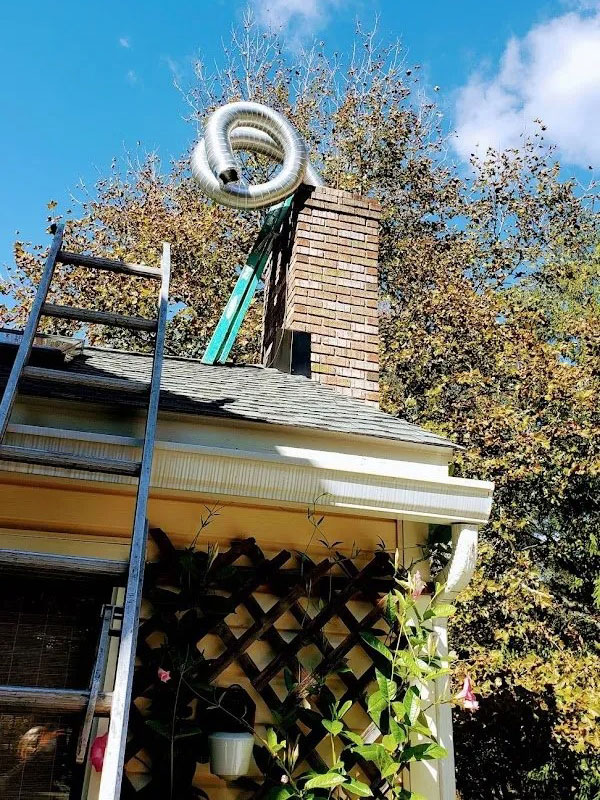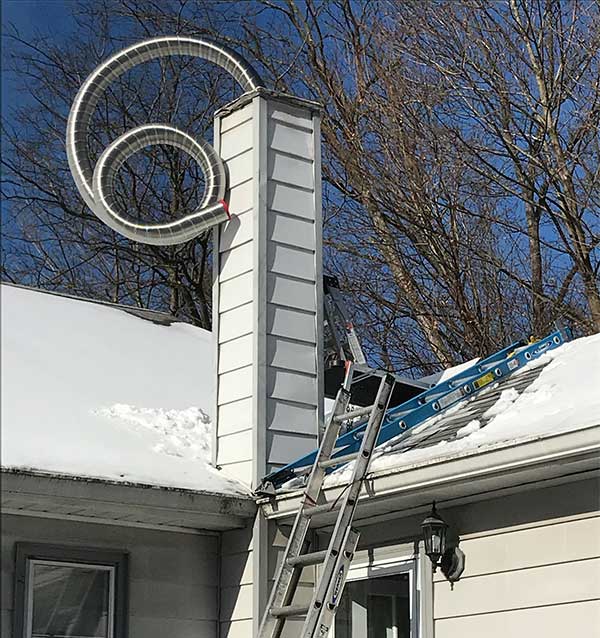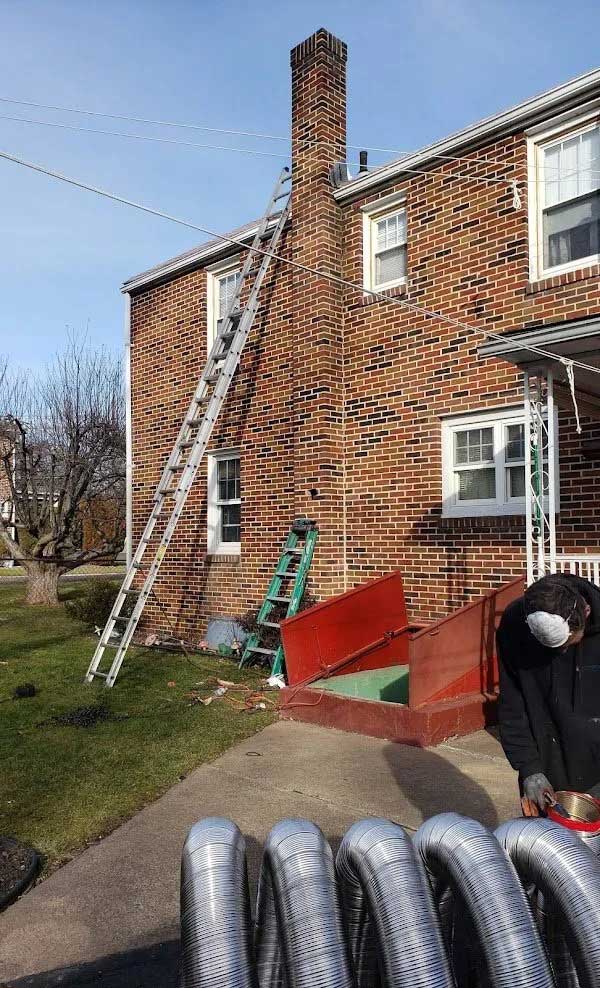Need Chimney Services In or Near Piscataway? Turn to the Certified Sweeps at Highpoint Chimney Services
When it comes to chimney and fireplace care in Piscataway, Bound Brook, Middlesex, Dunellen, Franklin Township, Pittstown, Washington, Highland Park, Edison, New Brunswick, South Plainfield, Reading, Manville, or anywhere else in the nearby areas, we’re the only crew to trust. HIre a team that puts you first – call today.
Have you checked the weather forecast recently? If it’s a nice day ahead, then you can’t go wrong spending time at local spots like East Jersey Old Town Village, Johnson Park, or Rutgers University Ecological Preserve.
But if snow, rain, or harsh winds are on their way, not even a quick trip to the library or post office is typically an option. Rather, you’d probably be better off staying indoors and lighting up a cozy fire. Ensure your fireplace, stove, or insert is ready for these bad-weather days by relying on Highpoint Chimney Services for your maintenance, repairs, and installations. We’re here for homeowners in Middlesex, Hunterdon, and Somerset counties.
We Provide Quality Chimney & Fireplace Services
No one wants to hire multiple companies to handle just one of their home maintenance needs. Could you imagine having to call one plumber to repair your sink, another one to install your new toilet, and a third company to repair a damaged pipe? That’d be a huge hassle.
Well, the same goes for fireplace care, which is why we’re proud to be a full-service chimney company, here to meet your every need. We offer a long list of services, including:
- Chimney Sweepings
- Chimney Inspections
- Level II Inspections
- Masonry Repairs
- Chimney Leak Repairs
- Chimney Waterproofing
- Chimney Relining
- HeatShield®
- Smoke Chamber Parging
- Refractory Panel Replacement
- Dryer Vent Cleaning
- Stove Installation
We can also install your new chimney cap, chase cover, throat damper, or lock-top damper, so be sure to reach out if any of your chimney components is missing or failing you.

Call Now
What Happens If My Chimney Isn’t Lined?
Sure, not every chimney system needs to come equipped with a fancy tool kit or a bunch of fireplace accessories. But certain parts like a chimney cap, a good-sealing damper, and a properly built crown are a must – and your chimney liner falls into this latter category too.
In fact, back in the day the National Bureau of Standards (now the National Institute of Standards and Technology) did some tests on chimney liners and discovered that not having one was extremely dangerous, and operating a chimney without one was “little less than criminal.”
So, what are the risks involved with operating an unlined chimney?
- Fire Hazards: A chimney that’s not lined is extremely dangerous to put to use. In fact, in the tests mentioned above, the results revealed flames reaching adjacent woodwork in only a few hours.
- Poor Draft: Proper airflow in your chimney is vital for ensuring smoke and fumes can move up and out safely. Liners play a huge role in efficiency and draft, so if your chimney is without one, you’re prone to experience issues like smoke backup, poor air quality, and potential gas leaks.
- Corrosion: Unlined chimneys are much more susceptible to corrosion and breakdowns, as they’ll be directly exposed to the acidic gases and smoke your fires produce. This could eventually result in a chimney collapse.
- Health Risks: If your system can’t vent properly and is more prone to fire hazards, the health and well-being of those living in the home will be at great risk. Air quality will suffer, the risk of carbon monoxide exposure will increase, and if fire spreads, this could cause serious injury as well.
- Home Damage: Fireplaces are built within the home, but they need to be regarded almost as a separate entity. In other words, the heat, fumes, gases, or flames from the fireplace shouldn’t reach any other part of your home, or you could face damage.

Is your chimney currently unlined? Then, do not put your fireplace to use and call in our sweeps right away to do an assessment. We can inspect the flue, complete any needed repair work, clear out any creosote or other buildup, and then find the best relining solutions for your needs, setup, and budget.
Call today, so we can get started.
How Do I Know Which Type of Chimney Liner Is Best for My Chimney?
Now, there are actually numerous ways to reline a chimney, using a variety of materials. This means that you can personalize your relining needs based on your budget, appliance type, preferences, and a variety of other factors.
So, what are some good considerations to keep in mind as you dive into this project?
What type of fuel do you have?
The type of fuel you use, whether it’s gas, wood, or something else, can impact what type of liner you’re able to get. For instance, stainless steel liners are fine to use with every type of fuel, while some are more or less compatible with other ones.
What size and shape is your appliance?
Your liner will obviously need to be correctly sized to your chimney, otherwise things won’t operate as efficiently as possible when the job is done. This is a major reason why trusting a professional to get the job done right is so imperative.

What’s your budget like?
Some liner options, like an aluminum liner for example, are much more cost-effective than a more heavy-duty type, like stainless steel. That said, it’s important to remember that aluminum liners need to be replaced more regularly, while stainless steel options should last you a lifetime. In fact, most come with a lifetime warranty (when installed and maintained by an expert).
HeatShield® can also be a more affordable (and long-lasting) option, if that’s an option for your system type. If you’re not sure where to start, reach out to our techs. We’ll get you where you need to be.
What are the different types of chimney liners Highpoint offers?
If you’re working with us, we have two liner options that we recommend for homeowners throughout our service area – HeatShield® and stainless steel.
- Stainless Steel: Stainless steel is always a good way to go because it doesn’t take long to install, and once it’s in, you can count on reliable protection for the long haul. It will resist corrosion and offer lasting protection for, quite literally, a lifetime.
- HeatShield®: This option tends to be less costly than relining with stainless steel, and there are three methods to choose from, depending on the extent of your damage. We’d be happy to go through these with you, then inspect your flue to see if one of the methods might work best for your system.
Schedule Appoıntment
How Often Do I Need to Reline My Chimney?
This is one of those questions that’s hard to answer because it can depend on several different factors. Usually the life span of your liner depends on the following:
- how well you take care of your chimney
- how often you invest in professional inspections and maintenance
- the type of liner you’ve invested in
- what you burn in your fireplace
For instance, if you burn wet wood, don’t invest in regular professional services, and purchased the cheapest material for your liner to begin with, then it could break down in only a matter of years. On the flip side, a professionally installed stainless steel liner in a chimney that’s annually inspected should last you decades.
So, why not give us a call now, and we can discuss your options? We can find the liner best suited to your needs, so you can stress less about the safety and efficiency of your fireplace in years to come.
How Do I Maintain My Chimney Liner to Avoid Damage?
Most chimney damages are preventable by taking proper care of your system and investing in professional services from a qualified and well-educated chimney sweep. In the end, investing in affordable and manageable maintenance early on is always going to be better than shelling out hundreds (or sometimes thousands) for extensive repairs later on.
So, what can be done to avoid damage?
- Book annual inspections. Before every burning season, get an inspection booked with a certified chimney sweep. This ensures any issues are spotted before you put your fireplace to use – and put your home at risk in the process.
- Burning seasoned wood – only. You can’t throw fresh logs into your fires and expect a good outcome. These produce more smoke and encourage creosote buildup, which then puts more wear on your system as a whole – and that includes your liner. Don’t burn trash, cardboard, treated wood, or plastic either.
- Watch for damage. Keep your eyes peeled and, if you spot an issue with your chimney liner, call in a sweep to get it resolved right away. If there’s damage in your chimney, it’ll only worsen with time, putting your home and family at risk in the process.
- Invest in a reliable chimney cap. Your chimney cap should be made from durable metal and installed correctly by a qualified tech. This will keep water and debris out of your chimney, so that your liner doesn’t face damage as a result.
- Don’t put off maintenance. Do you need a sweeping, a new chimney component, or some repairs completed? Don’t put off the care you need. The longer issues go unaddressed, the more they’ll spread – and the more expensive they’ll be to fix.
What are the signs that my chimney liner needs to be replaced or repaired?
Now, if the damage is already done, repairs will need to be the priority (after which, you can invest in preventive measures). So, what can you be on the lookout for in terms of potential damage?
- Cracks, gaps, or corrosion in the liner
- Smoke or heat escaping through the bricks of the chimney
- Any sign of water damage throughout the system
- Creosote buildup inside of the flue
- A damaged or missing chimney cap
- Cracks or damage to the chimney crown
- Damage or deterioration throughout the chimney masonry
- Poor draft or airflow
- Damaged or missing chimney flashing
- Unpleasant odors coming from the chimney
- Animal nests or debris inside the chimney
- Difficulty starting or maintaining a fire
- Increased carbon monoxide levels in the home
- Drafting issues or backdrafting
- A smoky or dirty fireplace or stove
If any of the above is occurring, your liner could be to blame – or it could be at risk. Call in our sweeps, so that we can get to the bottom of it, and find the best solutions for your needs.
We’ve Got Reliable Chimney Solutions
No matter what type of chimney issue you’re currently facing – be it a faulty liner, smoke in your home, broken down components, or something else – our full-service crew can help you out. We pride ourselves on putting the needs of our customers first, being certified with reputable organizations like the Chimney Safety Institute of America (CSIA), and always being up to date on the best techniques, the highest-quality products, and the latest industry regulations.
From start to finish, we’re the team to trust for any and all of your fireplace or chimney needs. If you live in Watchung, Somerville, Warren, Martinsville, or anywhere else in our service area give us a call at 908-864-4114 to get started, or you can reach out to us online. We can’t wait to hear from you.
We’re proud to include neighboring Somerset in our broad service area and love keeping their chimney systems safe to use year after year.
